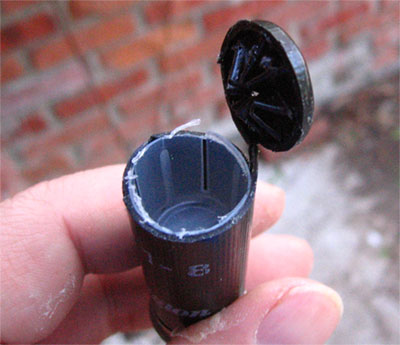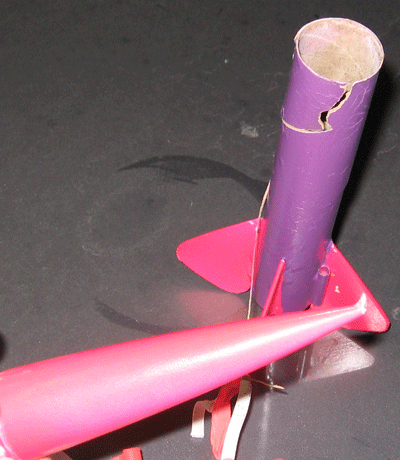Why do I care if it’s stable? Because an unstable rocket might come charging back at me. Or, more likely, just thrash about a few feet above the lunch rod and trash itself before the recovery charge blows.
Okay, this video is a bad example, because this was actually caused by a crack in a motor. Delta II rockets are uber-stable, and except for this one, I think all of them have successfully gotten to orbit.
Still, anything going faster than you can track it with your eyes is nothing you want coming back at you.

Luckily, just as it turns out artistic talent is not necessary (or maybe even desirable) for a career as a commercial artist, you can find out if a rocket is stable without doing even basic math.
Tie a string around the rocket at the center of gravity. This is easy to find: it’s the point where the rocket will balance on the string. Tape the string to the airframe to keep it from slipping, and don’t sweat it if you’re a millimeter off of the absolute CG after you’ve taped it. You’re close enough for jazz, because you want your CP (center of pressure) at least a caliber behind the CG. A caliber is the diameter of the rocket.

Yes, I chew my tongue while I do swing tests. See also when I play the guitar, when I’m building something, etc. I probably chew my tongue while I’m blogging, too.
I’ve built several rockets in anticipation of rocket flying weather, and wanting to be a responsible Lobster, I swing tested them. And they failed. Big time.
The fix is to add weight to the nose, bringing the center of gravity forward. Or you can move the fins back, except by the time you’re swing testing, you’ve already glued the fins on. Maybe there’s a reason to learn the math after all.
How to add weight? Nose cones are hollow plastic. Except the ones that are lathed from balsa. Of which I have a few, with a crayola shape to the nose, to make crayon-styled rockets. I guess I can drill a hole in the balsa to glue shot into. But for now, I’m switching to a plastic nose cone for the rocket formerly known as Crayola.
Lead shot is the easiest thing to use. It’s cheap, heavy, and comes in itty bitty beads you can pour into even a small nose cone.
I didn’t want to take the trouble to go to a gun store and get shot like they sell for dudes who load their own. So I bought a box of #8 at Wal-Mart. You know, guns don’t kill people, it’s the damn bullets: so naturally, Wal-Mart quit selling the guns, but not the ammo.

Okay, actually, it’s not even bullets: it’s assholes who kill people, and there’s fuckall you can do to keep them from getting guns and ammo. And if you do, they’ll just use a knife.
So I slash into the shells for the shot and there’s not that much lead in a shotgun shell. I mean, there’s an ounce to a shell, which makes it easy to know how much I’m adding to a nose cone, because you can kind of eyeball and say, that’s half of the shot from this shell, so it’s half an ounce of lead. But I would have thought the shot would take up more than a fourth the length of the shell.

Plaster (the big pink and black booger) was hardest to nose-weight because the nose cone is glued to the upper half. So I had to add the eight at the middle, because the transition piece is the foremost part I can get glue and lead to. And it worked: Plaster is cleared for takeoff next time it’s warm, not too windy, and I can press gang my honyocks into a trip to the park.

Sunflower, the other big-ass rocket I built, was more problematic. I added nose weight and it still wanted to go ass first. So I added some more. I’m talking about two ounces of lead. Ridunculous. To the point where I’m wondering if a C engine will even loft the thing high enough that it won’t be a sequel to Queen Izen (who went ballistic and crashed nose first before the recovery charge blew).
So then I’m swing testing it, and it’s flying straight and nose first, and I’m thrilled. And I remember, from the Handbook of Model Rocketry that the longer the line is, the more valid the swing test. So I let another foot or two of twine off the roll to let it fly faster and further, and it was really flying beautifully when it folded in half.
Shit on my sandals.

The weight of the motor in the tail and the lead shot in the nose cone exceeded the strength of four feet of paper tubing.
I think I can cut the crumpled section out and re-joint Sunflower as a shorter rocket, but no way I can launch her as is.

No comments:
Post a Comment